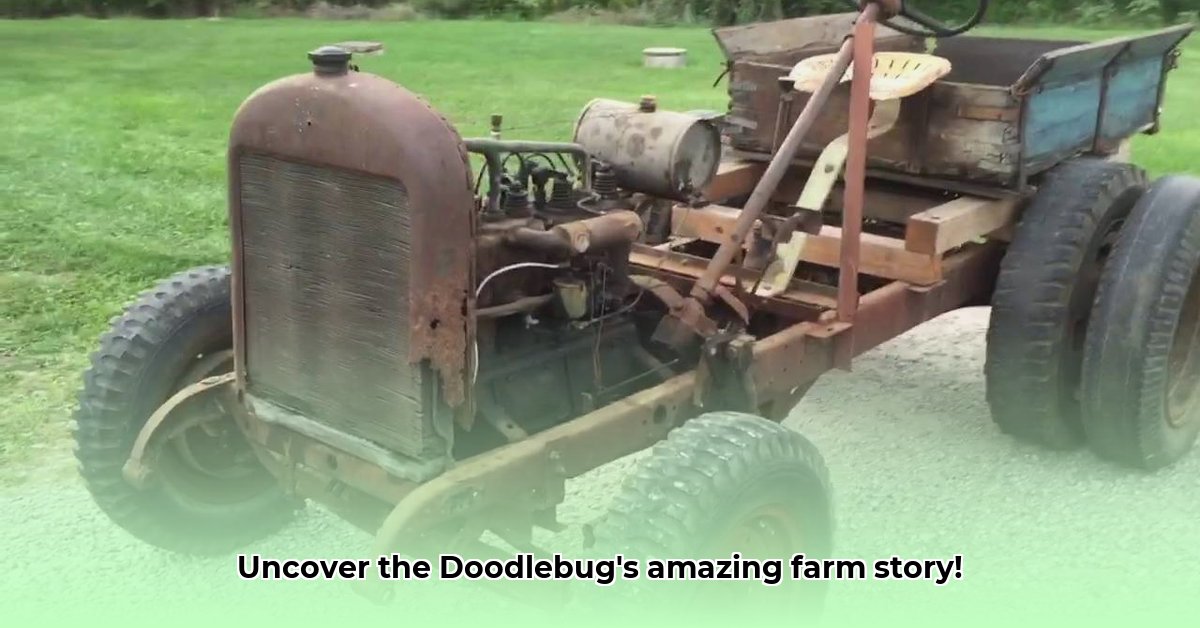
The sputtering engine coughed, a plume of blue-grey smoke hinting at the years of hard work etched into its metal frame. Across the parched fields of the Dust Bowl, a homemade tractor, a "doodlebug," stubbornly chugged along, a symbol of resilience in the face of adversity. This isn't just a story about machines; it's a testament to human ingenuity and the spirit of making do during the Great Depression. We'll explore the rise, fall, and remarkable resurgence of the doodlebug tractor, a fascinating piece of agricultural history. For more in-depth information, visit the Doodlebug Tractor History website.
The Rise of the Doodlebug: Necessity's Mother of Invention
The 1930s: a time of economic hardship and environmental devastation. Banks foreclosed, farmers lost their land, and the cost of new farm equipment was prohibitive. But the land still needed tilling. Across the United States, and even in Sweden facing similar economic woes, ingenious farmers found a solution: they converted discarded Ford Model A cars—readily available and relatively inexpensive—into makeshift tractors. These weren't uniformly called "doodlebugs"—names like "Friday tractors," "Scrambolas," and "Jitterbugs" reflect regional variations. Each name represents the unique adaptations farmers made to suit their local environments and individual farming needs. They weren't just machines; they were a testament to the human spirit, embodying the ethos of making the most of limited resources.
Did you know that the sheer number of doodlebugs built highlights a phenomenal grassroots mechanization effort? This wasn't merely about individual ingenuity; the extensive sharing of knowledge and modifications between neighboring farmers underscored the strength of their collective resourcefulness. These machines became far more than simple tools; they were symbols of hope and the determination to persevere despite the challenges.
From Model A to Mighty Machine: The Transformation
Converting a Ford car into a working tractor involved a significant amount of mechanical know-how. Farmers, often possessing surprising mechanical skills, stripped down the car chassis, reinforcing it to withstand the stresses of agricultural labor. The existing engine, transmission, and axles provided the powertrain. The ingenuity lay in modifying the gearing to achieve the appropriate speeds and power for plowing, planting, and harvesting. Finally, a rear-mounted implement—a plow, harrow, or other necessary tool—completed the transformation. Later, aftermarket conversion kits emerged, simplifying the process, but many farmers continued to modify their vehicles individually. The resulting machines, while not uniform, demonstrated the incredible adaptability of both the design and the inventive spirit of those who built them.
What were some of the most common modifications to convert a Model A into a working doodlebug? Common alterations included reinforced chassis, custom-built hitch systems for implementing farming tools, and adjustments to the transmission gear ratios to optimize power and speed for various agricultural tasks.
A Versatile Workhorse: Beyond the Plow
The doodlebug's adaptability extended beyond plowing. Farmers used them for hauling, haying, even clearing brush and tree stumps. The car's naturally high ground clearance proved surprisingly useful in navigating uneven terrain. Their versatility ensured that these remarkable machines could be adapted to a farmer's specific needs, further solidifying their importance during a time of scarce resources.
The Doodlebug's Limitations: A Balanced Perspective
While remarkably resourceful, doodlebug tractors weren't without their shortcomings. They lacked the power and efficiency of mass-produced tractors, had shorter lifespans due to their home-built construction, and presented inherent safety concerns. Yet, these limitations were often secondary to their critical impact during a period of profound economic hardship. For countless farmers, the doodlebug was not merely a machine but a lifeline, enabling them to continue working the land and providing for their families.
Why were safety concerns a significant factor when considering doodlebug tractors? The lack of standardized safety features present in mass-produced tractors and the inherent variability in their construction led to several safety hazards.
The Legacy of the Doodlebug: Preserving a Piece of History
Today, the doodlebug tractor represents more than just a piece of farm equipment; it embodies human resilience and the power of community. These ingenious machines are highly sought after by collectors and hobbyists, representing a fascinating chapter in American agricultural history. Restoring a doodlebug is a labor of love, a connection to the ingenuity of earlier generations. Museums are showcasing these marvels of homegrown engineering, and enthusiast clubs are dedicated to their preservation and restoration, ensuring their enduring legacy. Online communities further enhance this effort, fostering collaboration and knowledge sharing.
What resources are available for those interested in learning more about doodlebug tractors? Numerous resources exist, including historical societies, online communities, dedicated books and articles, and museums showcasing these remarkable machines.
Where to Find Out More: Actionable Steps
For anyone captivated by the story of the doodlebug, several avenues for further exploration exist:
Local Museums & Historical Societies: Begin by searching for local museums and historical societies in agricultural regions that may feature doodlebug tractors in their exhibits or archives. Many hold valuable artifacts and information.
Online Communities & Forums: Online forums and communities dedicated to antique tractors, particularly those focusing on the doodlebug, are invaluable resources. These online spaces foster collaboration and knowledge sharing among enthusiasts, providing support for restoration and historical research.
Specialized Books & Articles: Several books and articles document the history and mechanics of doodlebug tractors. These offer detailed technical information and valuable historical context, enriching the understanding of the design, construction, and use of these fascinating machines.
The doodlebug tractor—a symbol of ingenuity, perseverance, and the human spirit's ability to overcome adversity—remains a captivating piece of agricultural history. Its story deserves to be remembered not only for its historical significance but also for the enduring spirit of innovation it represents.